8-8 duoprism
In geometry of 4 dimensions, a 8-8 duoprism or octagonal duoprism is a polygonal duoprism, a 4-polytope resulting from the Cartesian product of two octagons.
Uniform 8-8 duoprism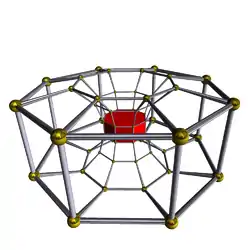 Schlegel diagram | |
|---|---|
| Type | Uniform duoprism |
| Schläfli symbol | {8}×{8} = {8}2 |
| Coxeter diagrams | |
| Cells | 16 octagonal prisms |
| Faces | 64 squares, 16 octagons |
| Edges | 128 |
| Vertices | 64 |
| Vertex figure | Tetragonal disphenoid |
| Symmetry | [[8,2,8]] = [16,2+,16], order 512 |
| Dual | 8-8 duopyramid |
| Properties | convex, vertex-uniform, facet-transitive |
It has 64 vertices, 128 edges, 80 faces (64 squares, and 16 octagons), in 16 octagonal prism cells. It has Coxeter diagram ![]()
![]()
![]()
![]()
![]()
![]()
![]()
Images
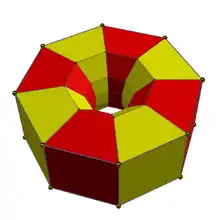
The uniform 8-8 duoprism can be constructed from [8]×[8] or [4]×[4] symmetry, order 256 or 64, with extended symmetry doubling these with a 2-fold rotation that maps the two orientations of prisms together. These can be expressed by 4 permutations of uniform coloring of the octagonal prism cells.
| [[8,2,8]], order 512 | [8,2,8], order 256 | [[4,2,4]], order 128 | [4,2,4], order 64 |
|---|---|---|---|
 |
 |
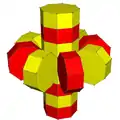 |
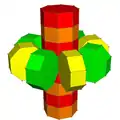 |
| {8}2 | {8}×{8} | t{4}2 | t{4}×t{4} |
Seen in a skew 2D orthogonal projection, it has the same vertex positions as the hexicated 7-simplex, except for a center vertex. The projected rhombi and squares are also shown in the Ammann–Beenker tiling.
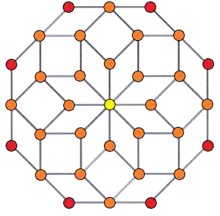 |
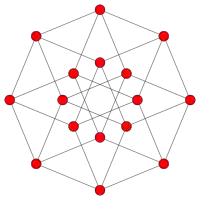 |
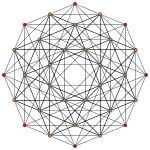 | |
| 8-8 duoprism |
4-4 duoprism |
Hexicated 7-simplex | |
|---|---|---|---|
 |
 |
 | |
| Ammann–Beenker tiling | {8/3} octagrams | ||
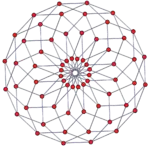 | |||
| 8-8 duoprism | |||
Related complex polygons

The regular complex polytope 8{4}2, ![]()
![]()
![]()
It also has a lower symmetry construction, ![]()
![]()
![]()
8-8 duopyramid
| 8-8 duopyramid | |
|---|---|
| Type | Uniform dual duopyramid |
| Schläfli symbol | {8}+{8} = 2{8} |
| Coxeter diagrams | |
| Cells | 64 tetragonal disphenoids |
| Faces | 128 isosceles triangles |
| Edges | 80 (64+16) |
| Vertices | 16 (8+8) |
| Symmetry | [[8,2,8]] = [16,2+,16], order 512 |
| Dual | 8-8 duoprism |
| Properties | convex, vertex-uniform, facet-transitive |
The dual of a 8-8 duoprism is called a 8-8 duopyramid or octagonal duopyramid. It has 64 tetragonal disphenoid cells, 128 triangular faces, 80 edges, and 16 vertices.
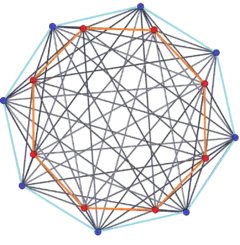 |
 |
| Skew | [16] |
|---|
Related complex polygon

The regular complex polygon 2{4}8 has 16 vertices in with a real representation in matching the same vertex arrangement of the 8-8 duopyramid. It has 64 2-edges corresponding to the connecting edges of the 8-8 duopyramid, while the 16 edges connecting the two octagons are not included.
The vertices and edges makes a complete bipartite graph with each vertex from one octagon is connected to every vertex on the other.[2]
Related polytopes
The 4-4 duoantiprism is an alternation of the 8-8 duoprism, but is not uniform. It has a highest symmetry construction of order 256 uniquely obtained as a direct alternation of the uniform 8-8 duoprism with an edge length ratio of 0.765 : 1. It has 48 cells composed of 16 square antiprisms and 32 tetrahedra (as tetragonal disphenoids). It notably occurs as a faceting of the disphenoidal 288-cell, forming part of its vertices and edges.

Vertex figure for the 4-4 duoantiprism
Also related is the bialternatosnub 4-4 duoprism, constructed by removing alternating long rectangles from the octagons, but is also not uniform. It has a highest symmetry construction of order 64, because of the alternation of square prisms and antiprisms. It has 8 cubes (as square prisms), 4 square antiprisms, 4 rectangular trapezoprisms (topologically equivalent to a cube but with D2d symmetry), with 16 triangular prisms (as Csv-symmetry wedges) filling the gaps.
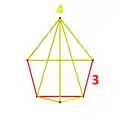
Vertex figure for the bialternatosnub 4-4 duoprism
See also
Notes
- Coxeter, H. S. M.; Regular Complex Polytopes, Cambridge University Press, (1974).
- Regular Complex Polytopes, p.114
References
- Regular Polytopes, H. S. M. Coxeter, Dover Publications, Inc., 1973, New York, p. 124.
- Coxeter, The Beauty of Geometry: Twelve Essays, Dover Publications, 1999, ISBN 0-486-40919-8 (Chapter 5: Regular Skew Polyhedra in three and four dimensions and their topological analogues)
- Coxeter, H. S. M. Regular Skew Polyhedra in Three and Four Dimensions. Proc. London Math. Soc. 43, 33-62, 1937.
- John H. Conway, Heidi Burgiel, Chaim Goodman-Strass, The Symmetries of Things 2008, ISBN 978-1-56881-220-5 (Chapter 26)
- Norman Johnson Uniform Polytopes, Manuscript (1991)
- N.W. Johnson: The Theory of Uniform Polytopes and Honeycombs, Ph.D. Dissertation, University of Toronto, 1966
- Catalogue of Convex Polychora, section 6, George Olshevsky.
External links
- The Fourth Dimension Simply Explained—describes duoprisms as "double prisms" and duocylinders as "double cylinders"
- Polygloss - glossary of higher-dimensional terms
- Exploring Hyperspace with the Geometric Product